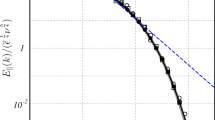Abstract
Hinze’s conceptual model for turbulence near a wall is modelled by a linear constitutive equation and closure hypothesis on an intrinsic rotational degree of freedom. Integration of the model equations yield the universal logarithmic profile for velocity in the transition layer. Verhulst-type non-linear growth of transition layer vorticity is normalized and discretized to an iteration along the real axis of the complex Mandelbrot algorithm with \( {Z_{{n + 1}}} = {Z_{n}}^{2} +\frac{1}{4} \) . This locates vorticity iteration in the transition layer precisely on the domain boundary between a zero-vorticity attractor for the free stream, and an infinite- vorticity attractor for the wall.
Hinze’s horseshoe vortices are modelled as kink-free constructions of scaling circle arcs analogous to Mandelbrot’s line-based “teragon” constructions for Koch- and Peanocurves. Circular initial vortex rings in a superfluid are deformed into differentiable fractal curves growing inward and/or outward without self-intersections. General formulas for three types of admissible circle deformations are given, and their scale factors, growth rates and fractal dimensions are tabulated. Conservation of angular momentum accelerates circulating light nuclei in a discharge plasma above nuclear reaction velocities in twelve stages of the strongest fractal stretching process.
Access this chapter
Tax calculation will be finalised at checkout
Purchases are for personal use only
Preview
Unable to display preview. Download preview PDF.
Similar content being viewed by others
References
H. Kikuchi, Meteorological-electric phenomena and electrohydrodynamics (EHD) or electrommagnetohydrodynamics (EMHD); Electromagnetodynamic vortices and corn circles, in: “Environmental and Space Electromagnetics”, H. Kikuchi, ed., Springer Verlag (1991).
J. O. Hinze, “Turbulence”, McGraw-Hill, New York, (1975).
G. C. Dijkhuis, Boundary layer model and calculation for horizontal thundercloud electrificaton preceding natural and rocket-triggered lightning, in: “Environmental and Space Electromagnetics”, H. Kikuchi, ed., Springer Verlag (1991).
G. N. Shah et al., Neutron generation in lightning bolts, Nature 313: 773 (1985).
B. M. Smirnov, Physics of Ball lightning, Physics Reports 224 No. 4 (1993).
G. C. Dijkhuis and J. Pijpelink, Performance of high-voltage test facility designed for investigation of ball lightning, in: “Science of Ball Lightning (Fireball)”, Y.-H. Ohtsuki, ed., World Scientific Publishing Co., Singapore (1989).
G. C. Dijkhuis, Statistics and structure of ball lightning, in: “Proceedings of the Third International Symposium on Ball Lightning”, S. Singer, ed., (in press).
V. Nardi et al., Internal structure of electron-beam filaments, Phys. Rev. A 22: 2211 (1980).
K. L. Schwarz, Three-dimensional vortex dynamics in superfluid “Helium: Homogeneous superfluid turbulence, Phys. Rev. B 38: 2398 (1988).
H. van Beelen et al., On a balance equation for superfluid vorticity in capillary flow of helium II, Physica B 153: 248 (1988).
G. Gamota, et al., Evolution of a pulse of charged vortex rings in superfluid helium, Phys Rev. Letters 26: 960 (1971).
A. L. Fetter, Vortices and ions in helium, in: “The physics of liquid and solid helium”, K. H. Bennemann and J. B. Ketterson, eds., John Wiley & Sons (1976).
N. V. D’en and A. T. Listrov, Nonisothermal model of asymmetric fluid, Mekhanika Zhidkosti i Gaza (Fluid Dynamics) 2: 87 (1967).
R. F. Avramenko, et al., Experimental investigation of the compact high-energy plasmoids, in: “Proceedings of the Vizotum ′93 Congress on Ball Lightning”, A. G. Keul, ed., Salzburg University, Salzburg, Austria (in press).
G. C. Dijkhuis, “Thermally Driven Mass Flows in the Convection Zone of the Sun, Thesis,” Stanford University, California, USA (1973).
G. C. Dijkhuis, An alternative to mixing-length models for the turbulent boundary layer, Von Karman Institute for Fluid Dynamics, Brussels, Belgium (1978).
B. B. Mandelbrot, “The Fractal Geometry of Nature”, Freeman, New York, (1983).
H.-O. Peitgen and P. H. Richter, “The Beauty of Fractals”, Springer Verlag (1986).
Author information
Authors and Affiliations
Editor information
Editors and Affiliations
Rights and permissions
Copyright information
© 1994 Springer Science+Business Media New York
About this chapter
Cite this chapter
Dijkhuis, G.C. (1994). Verhulst Dynamics and Fractal Stretching of Transition Layer Vorticity. In: Kikuchi, H. (eds) Dusty and Dirty Plasmas, Noise, and Chaos in Space and in the Laboratory. Springer, Boston, MA. https://doi.org/10.1007/978-1-4615-1829-7_14
Download citation
DOI: https://doi.org/10.1007/978-1-4615-1829-7_14
Publisher Name: Springer, Boston, MA
Print ISBN: 978-1-4613-5740-7
Online ISBN: 978-1-4615-1829-7
eBook Packages: Springer Book Archive




